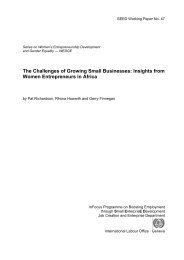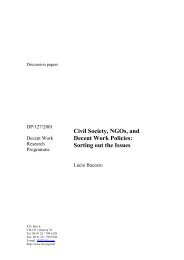Nepal Trafficking in Girls With Special Reference to Prostitution: A ...
Nepal Trafficking in Girls With Special Reference to Prostitution: A ...
Nepal Trafficking in Girls With Special Reference to Prostitution: A ...
You also want an ePaper? Increase the reach of your titles
YUMPU automatically turns print PDFs into web optimized ePapers that Google loves.
A Rapid Assessment<br />
V: Expla<strong>in</strong><strong>in</strong>g <strong>Traffick<strong>in</strong>g</strong><br />
<strong>Traffick<strong>in</strong>g</strong> can only be expla<strong>in</strong>ed by consider<strong>in</strong>g<br />
poverty <strong>in</strong> the context of social, cultural,<br />
demographic and political fac<strong>to</strong>rs at<br />
<strong>in</strong>dividual, family, community and<br />
national level.<br />
The root cause of traffick<strong>in</strong>g <strong>in</strong> <strong>Nepal</strong> differs<br />
from one locality <strong>to</strong> another, one sub-culture<br />
<strong>to</strong> another, one family <strong>to</strong> another and one<br />
<strong>in</strong>dividual <strong>to</strong> another.<br />
5.1 Child Vulnerability<br />
We have previously def<strong>in</strong>ed child vulnerability<br />
by the follow<strong>in</strong>g number of fac<strong>to</strong>rs (not prioritized)<br />
at the immediate family level: fragile family situation<br />
(alcoholism, unemployment, sexual abuse, domestic<br />
violence), poverty and very low <strong>in</strong>come, children not<br />
enrolled <strong>in</strong> school, sisters already trafficked, illness<br />
among parents. At the local community level one or<br />
more of the follow<strong>in</strong>g fac<strong>to</strong>rs may <strong>in</strong>crease the vulnerability<br />
of the child be<strong>in</strong>g trafficked: wrong perceptions<br />
about the dest<strong>in</strong>ations perpetually reproduced<br />
through traffick<strong>in</strong>g networks, anecdotal evidence of<br />
school teachers, politicians be<strong>in</strong>g <strong>in</strong>volved <strong>in</strong> traffick<strong>in</strong>g,<br />
abusive school teachers, neighbours’ children<br />
already trafficked, no employment opportunity for<br />
adolescents, vic<strong>in</strong>ity <strong>to</strong> roads lead<strong>in</strong>g <strong>to</strong> urban areas<br />
or <strong>to</strong> trade routes <strong>to</strong> India.<br />
Most key <strong>in</strong>formants noted that traffick<strong>in</strong>g is<br />
related <strong>to</strong> child vulnerability, exacerbated by deprivation<br />
from education.<br />
In <strong>Nepal</strong>, education up <strong>to</strong> the secondary level is<br />
free but not compulsory 1 . However, free education<br />
appears <strong>to</strong> be a half-truth as households have <strong>to</strong> <strong>in</strong>cur<br />
half of the <strong>to</strong>tal public cost of education 2 . Besides,<br />
the opportunity cost of go<strong>in</strong>g <strong>to</strong> school <strong>in</strong> relation <strong>to</strong><br />
work is <strong>to</strong>o high for households that are so poor that<br />
their livelihood must be supported by child labour.<br />
Furthermore, parents do not see the long-term benefits<br />
of education when the content is <strong>in</strong>compatible<br />
with their family needs.<br />
In our study, 38 out of 100 trafficked/sexuallyexploited<br />
girls were illiterate. Although it is expected<br />
that better education will enhance the chances for ac-<br />
cess <strong>to</strong> more and more reliable <strong>in</strong>formation for vulnerable<br />
girls and their families, the data also reveal<br />
that literacy alone may not translate <strong>in</strong><strong>to</strong> a decrease <strong>in</strong><br />
traffick<strong>in</strong>g as more than 50 % of the trafficked girls<br />
have had a few years of education.<br />
The grow<strong>in</strong>g effect of consumerism on<br />
children’s lives, exposure <strong>to</strong> modern culture, the desire<br />
<strong>to</strong> earn easy money, and peer pressure also make<br />
children more vulnerable.<br />
Some respondents were found <strong>to</strong> be engaged <strong>in</strong><br />
prostitution or were trafficked because they themselves<br />
desired <strong>to</strong> have good clothes, make-up kits and/<br />
or easy money. Many were found <strong>to</strong> have been will<strong>in</strong>g<br />
<strong>to</strong> leave their home<strong>to</strong>wns, not necessarily <strong>to</strong> brothels,<br />
but <strong>to</strong> the city area, a movement that made them<br />
more vulnerable <strong>to</strong> be<strong>in</strong>g approached by strangers.<br />
Four respondents, who were work<strong>in</strong>g as waitresses,<br />
were lured <strong>in</strong><strong>to</strong> sexual exploitation by a trafficker say<strong>in</strong>g<br />
that they would get Rs. 30,000 if they would<br />
smuggle diamonds for two days.<br />
5.2 Family Vulnerability<br />
Family vulnerability leads <strong>to</strong> child vulnerability.<br />
Access <strong>to</strong> education, health and nutrition largely<br />
depends on the family’s social and economic situation.<br />
In particular, mothers who are educated have been<br />
found <strong>to</strong> be nurs<strong>in</strong>g their children better <strong>in</strong> many countries.<br />
Family vulnerability <strong>in</strong>creases when family<br />
members, particularly girls, are denied education, and<br />
also <strong>in</strong> cases of deaths, sickness and domestic violence<br />
<strong>in</strong> the family.<br />
5.2.1 Education of Parents and Gender<br />
Discrim<strong>in</strong>ation<br />
An overwhelm<strong>in</strong>g majority of parents of trafficked<br />
girls are illiterate, especially the mothers. The<br />
lowest <strong>in</strong>dica<strong>to</strong>r of this is found <strong>in</strong> Sundhupalchowk,<br />
where only eight <strong>in</strong> 100 female adults are literate, and<br />
39 of 100 adult men are literate. In Nuwakot, which is<br />
located adjacent <strong>to</strong> Sundhupalchowk, only 10.8 % of<br />
adult females are literate. This is considerably under<br />
the national average of 21.3 % Table 5.1.<br />
1 Households have <strong>to</strong> bear the cost for school-dress, books and stationery, admission<br />
and exam<strong>in</strong>ation fees.<br />
2 Households which send children <strong>to</strong> public schools, on the average, spend Rs. 838<br />
on each child at the primary level and they spend Rs. 2,168 for a child at secondary<br />
level (<strong>Nepal</strong> South Asia Centre, 1998: 91). This is much higher expenditure <strong>in</strong> poor<br />
households with large family size.<br />
3 3

















